How to Get More HVAC Leads (Without Buying Them)
If you want more leads then you need to tell more people about the problems you solve with the services you provide.
A lot of people throw around the word “lead” to describe anyone they might be able to sell to. But not all leads are created equal.
Some leads deserve more of your attention than others. And that’s why I recommend you get in the habit of using different terms to describe leads.
A lead is a person you can contact. If you can email them, call them, message them on social media, or knock on their door, then we call them a lead. Your goal with leads is to get them to become engaged with you by showing interest in what you sell.
An engaged lead is a person that shows interest in what you sell and gives you a way to contact them.
Someone who visits your website is not an engaged lead. Someone who submits a form on your website and gives you their email or phone number is.
If someone follows you on social or engages with your content and you can message them, then they are an engaged lead also. If you’re doing cold outreach and someone responds positively, they are an engaged lead.
You get leads by telling people about your services. You get engaged leads by getting those people you tell to show interest.
So let’s talk about how we get people interested.
Create a Lead Magnet
Your services are the main thing you sell. Telling people about the main thing you sell might be good enough to get leads to show interest. Start by trying this first.
However, if you’ve already been advertising the services you sell and you aren’t getting enough leads, then you can often solve this problem by advertising a lead magnet.
A lead magnet is a complete solution to a narrow problem that, when solved, makes people aware of another problem that you sell a solution for.
You can charge for your lead magnet or make it free. If you do charge, it should be relatively low-cost. And if you’re struggling to get more leads right now, my advice is to make it free.
If you make something people want and give it away for free you will get more engaged leads. As a general rule of thumb, the more valuable your free thing is, the more engaged leads you’ll get.
This is usually where people start worrying about getting low-quality leads that waste their time. I get it. But you don’t know if that’s going to happen. If that happens, there are solutions. Right now you don’t have enough leads. Solve that first.
Example for HVAC Replacement Leads
Let’s say you want more HVAC replacement leads. What are the steps before replacing an HVAC system?
- They want to know what size and type of system they need
- They want to know what it will cost
- They need a way to pay for it
- They may need ductwork repair or replacement
- They may need temporary heating or cooling during installation
Pick one of these narrow problems and offer to solve it for free.
Example: You offer a free tool on your website where homeowners can enter their home size, layout, and desired climate to get recommendations on systems, price, and a button to get an installation quote.
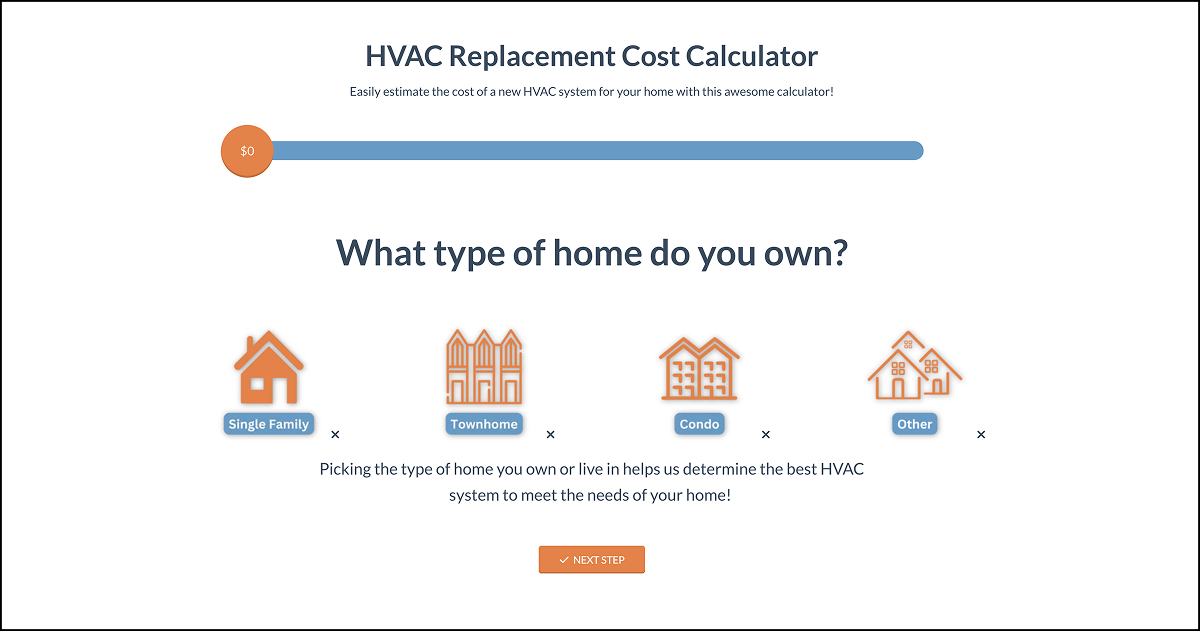
Example: You offer a free tool showing local utility rebates, tax credits, and financing options.
Example: You offer a free in-home estimate including a full Manual J calculation and stamped design showing the exact system capacity, tonnage, and type that fits their home.
Example: You offer a free portable AC/heater unit rental during installation period. This is more of a bonus, but you can turn it into a lead magnet by tying it to a specific promotional period to convince people who’ve been thinking about a replacement to pull the trigger.
Example for HVAC Recurring Maintenance Leads
Let’s say you want more leads for a recurring maintenance plan you offer. What do homeowners want or need before this?
- They may need replacement filters
- They want a tune-up before the season starts
- They may need their coils or filters cleaned
- They may need their refrigerant levels checked
- They may need their thermostat calibrated
- They may need to fix an issue like a leak
Like before, you pick one of these narrow problems and offer to solve it or some component of it for free.
Example: You offer a free 10-point seasonal HVAC tune-up to make sure the system is ready before summer or winter hits, including visual inspection, filter check, and thermostat test.
Example: You offer a free outdoor coil cleaning service that removes dirt and debris to improve airflow and efficiency, showing homeowners an instant before-and-after difference.
Example: You offer a free leak inspection that checks refrigerant and condensate lines for visible leaks or blockages, with a same-day repair option if an issue is found.
Now, if you offer one of these there are two important things to do so you don’t waste your time giving free stuff to people who won’t ever pay for your recurring service:
- Only offer it to qualified leads. For example, you could only offer this lead magnet to dual-income homeowners in specific neighborhoods with a combined household income over $180,000. Why? Because the more money people have the more they’d rather just pay for peace of mind so they know someone else is taking care of it and they don’t ever have to worry about it. And if you’re running paid ads, you can somewhat control who sees this offer by restricting what neighborhoods it can appear in.
- Sell the recurring plan before you fix an issue. You always want to sell at the point of greatest deprivation. If you fix an issue and they can perceive the difference, they’re less likely to buy a recurring service because the problem doesn’t exist anymore. Identify the issue, tell them you can solve it, offer the recurring option so it doesn’t happen again in the future, then fix it.
Just Do This If You’re Not Sure
Can’t figure out what to offer as a lead magnet? Just do this:
- Look at what your competitors charge for.
- Figure out what the hard costs would be for you to deliver it.
- Give it away for free.
- See how many leads you get.
- See how many you convert to buying your paid service.
- See if the math makes sense to keep giving it away for free.
- Either keep giving it away for free or figure out how to make the economics work.
You can make the economics work by slicing off a more narrow part of the solution, restricting the offer to people most likely to buy your paid service, reducing your labor or material costs, or charging just enough so you break even on the lead magnet offer and make up for it on the increase in downstream sales for your more expensive services.
Oh, and if you’re still not convinced you should do something for free.
That’s fine.
Just know that if your competitor does, they will get more engaged leads. More engaged leads means they’ll make more sales. More sales means they can saturate the market with more advertising and suck up all the good technicians.
There’s a finite amount of customers, ad inventory, and talent in every market. And every time they get more of something, you get less. That’s just how supply and demand works.
Get Leads Through One of These Four Ways
You get leads by telling people about your stuff. And there are only four ways one person can do that. Let’s break down each one so you know which to focus on and how to get started.
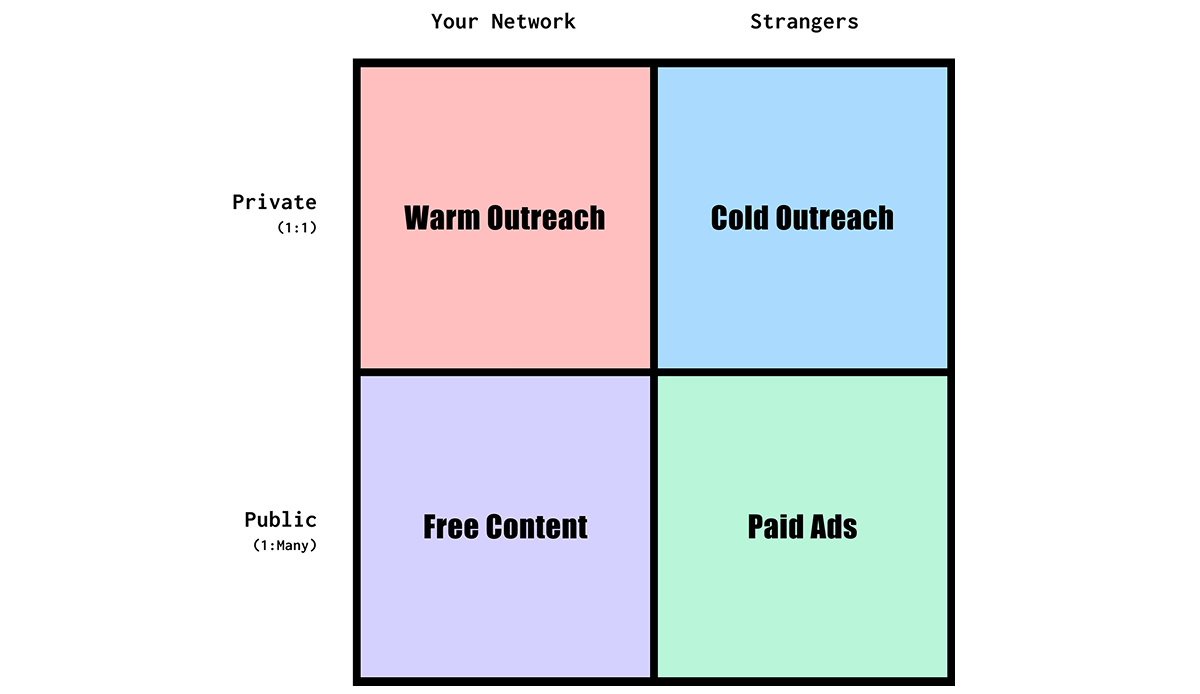
Warm Outreach
Warm outreach is where you tell people who know who you are about your services one-on-one. This is the cheapest and easiest way to find people interested in buying your stuff.
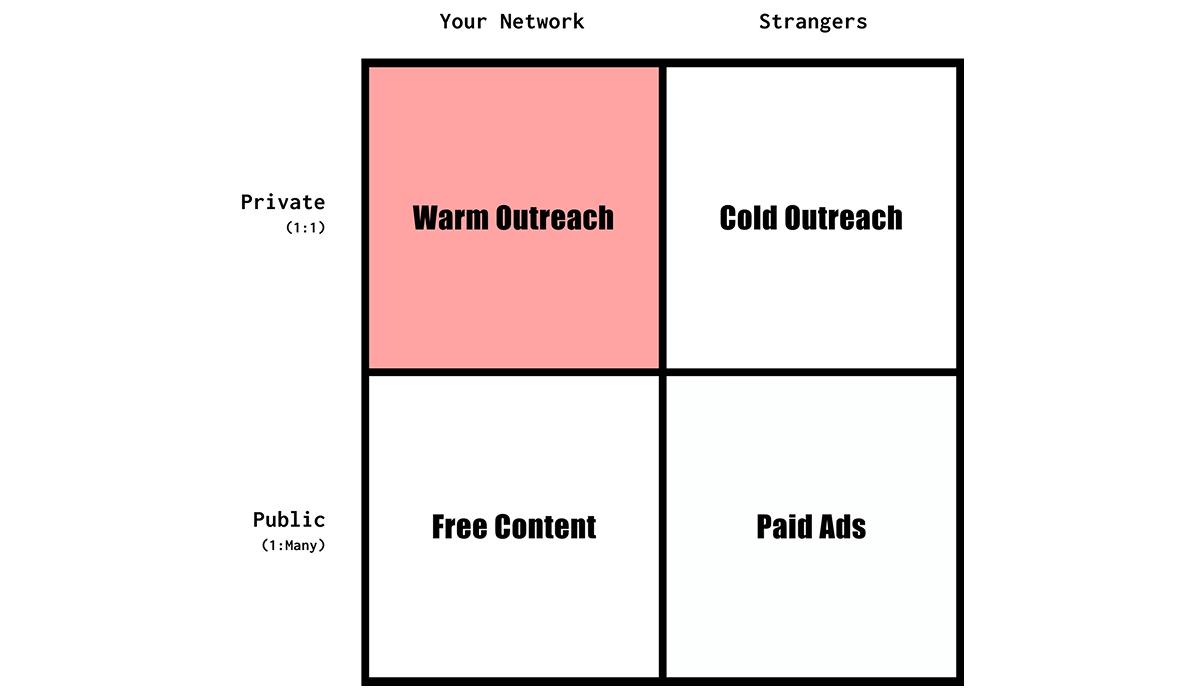
You can either tell them about your lead magnet (your valuable free thing) or your main service (the thing you sell at the highest price with the best margins).
Warm outreach works great for small HVAC owners just trying to get their business off the ground as well as more established ones (after all, all your previous customers know who you are and can hire you again).
Not sure where to get a list of people who know who you are that you can contact?
Open your phone and scroll through your contacts. Open your email and scroll people you’ve talked to. Open social media and scroll through everyone you’re connected with. Open your door and look around at your neighbors. Talk to people at your church, your kid’s baseball games, the people you see every time you get your oil changes.
Just. Look. Around.
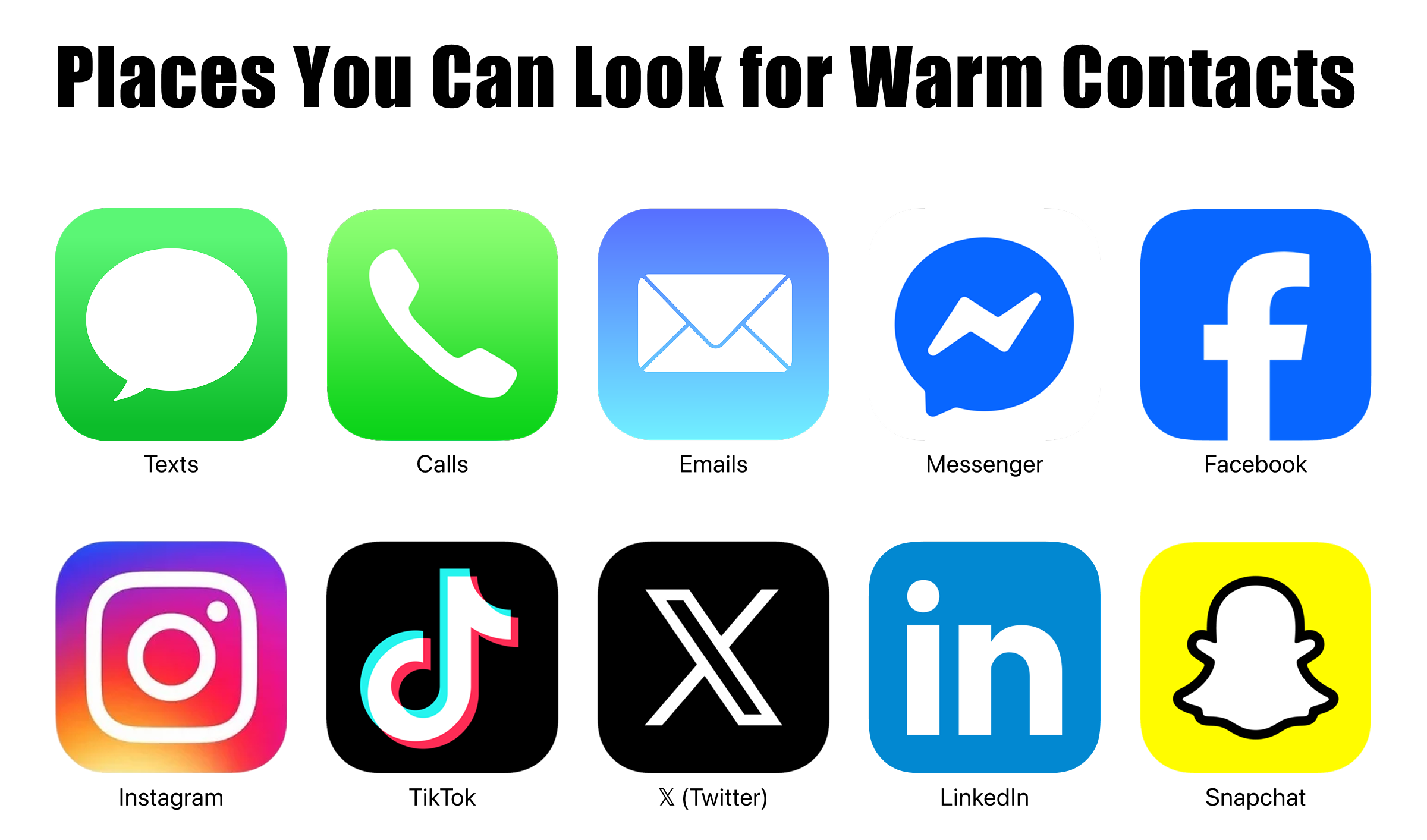
They have to know you, you don’t have to know them. That said, it tends to work best if you prioritize the people you know who know you first, then work through the people who know you that you may not know (think people who follow you on social media).
Find a reason to reach out to them. For example, take five minutes to check social and see what’s new in that person’s life. Opening the conversation with that, compliment them, and ask a question.
You can do this by text, social, email, phone, in person, etc.
If you’re not doing this by phone or in person, you can send your message, move down your list, then do the same thing with the next person.
Someone will eventually respond. When they do, acknowledge what they said, give them a compliment, then ask another question.
Don’t just start pushing your services either. Keep asking a question, repeating back what they said, giving them a compliment, and asking another question until the time is right.
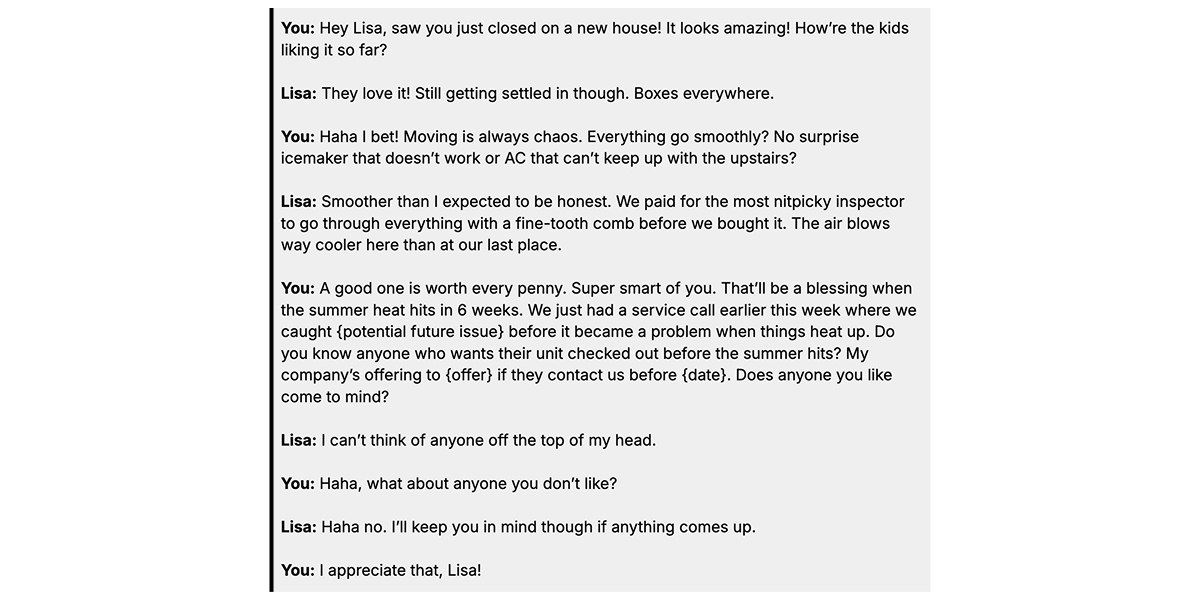
You won’t get a yes from every conversation. That’s fine.
Send 100 of these messages every day and you won’t have a problem getting leads anymore.
When you work your way through your entire list, start back again from the top because, yes, you can reach out to the same person more than once. Even if they weren’t interested and didn’t know anyone else who might be the last time.
I know a lot of people are afraid of telling people they know about what they have to offer. If you feel that way too, you’re not alone. But what you’re probably really afraid of is rejection.
And I get it.
But businesses do not grow themselves. People can’t pay you for your services if they don’t know you or your brand exists. And if you’re just starting out, that means it’s gotta be you. You have to put yourself out there and learn to deal with rejection.
If you’re too worried about what people who know you will think of you, then message people who don’t know you. That’s cold outreach and what we’ll cover next.
Cold Outreach
Cold outreach is where you tell people, one-on-one, about your services who don’t know who you are. Cold outreach is just about as cheap as warm outreach. You can expect to message about ten times the number of people to get an engaged lead, though.
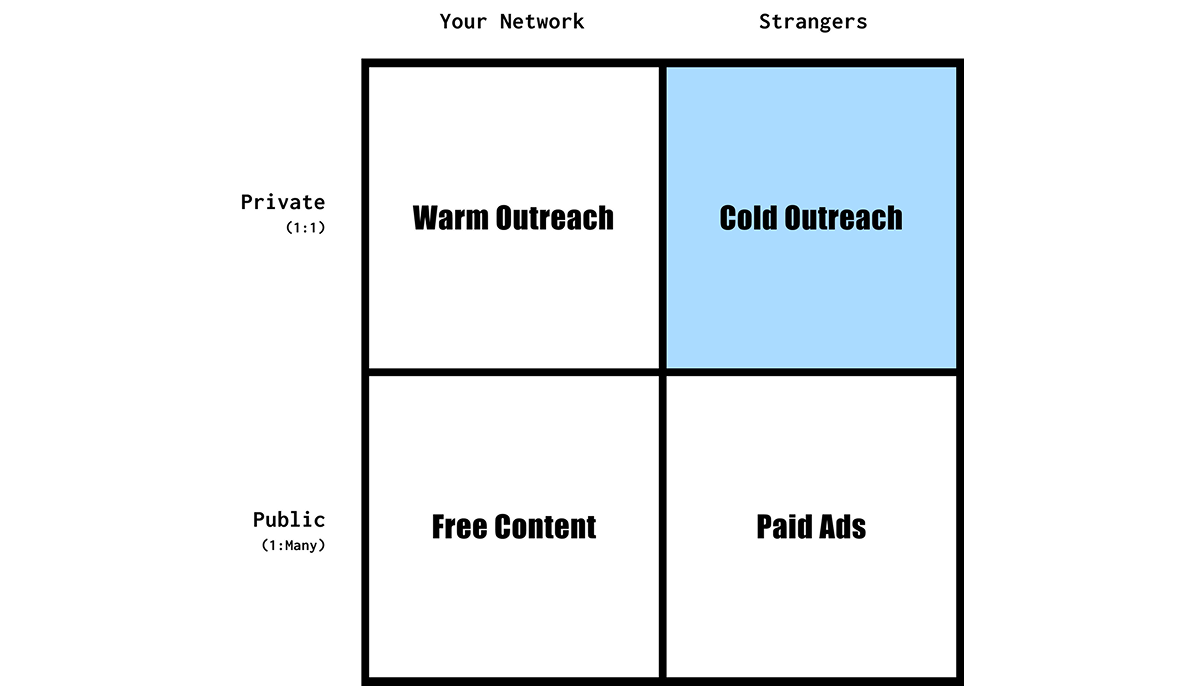
That’s okay. You’ll burn through your list of contacts who know you pretty fast. Cold outreach makes up for that because there will always be more people who know don’t you than who do.
The principles of cold outreach are similar to warm outreach, but with a few key differences. Especially depending on whether you’re trying to get more residential customers (B2C) or more commercial customers (B2B).
You’ll still build a list of people to contact, look them up, find a relevant reason to contact them, reach out, then follow-up as needed.
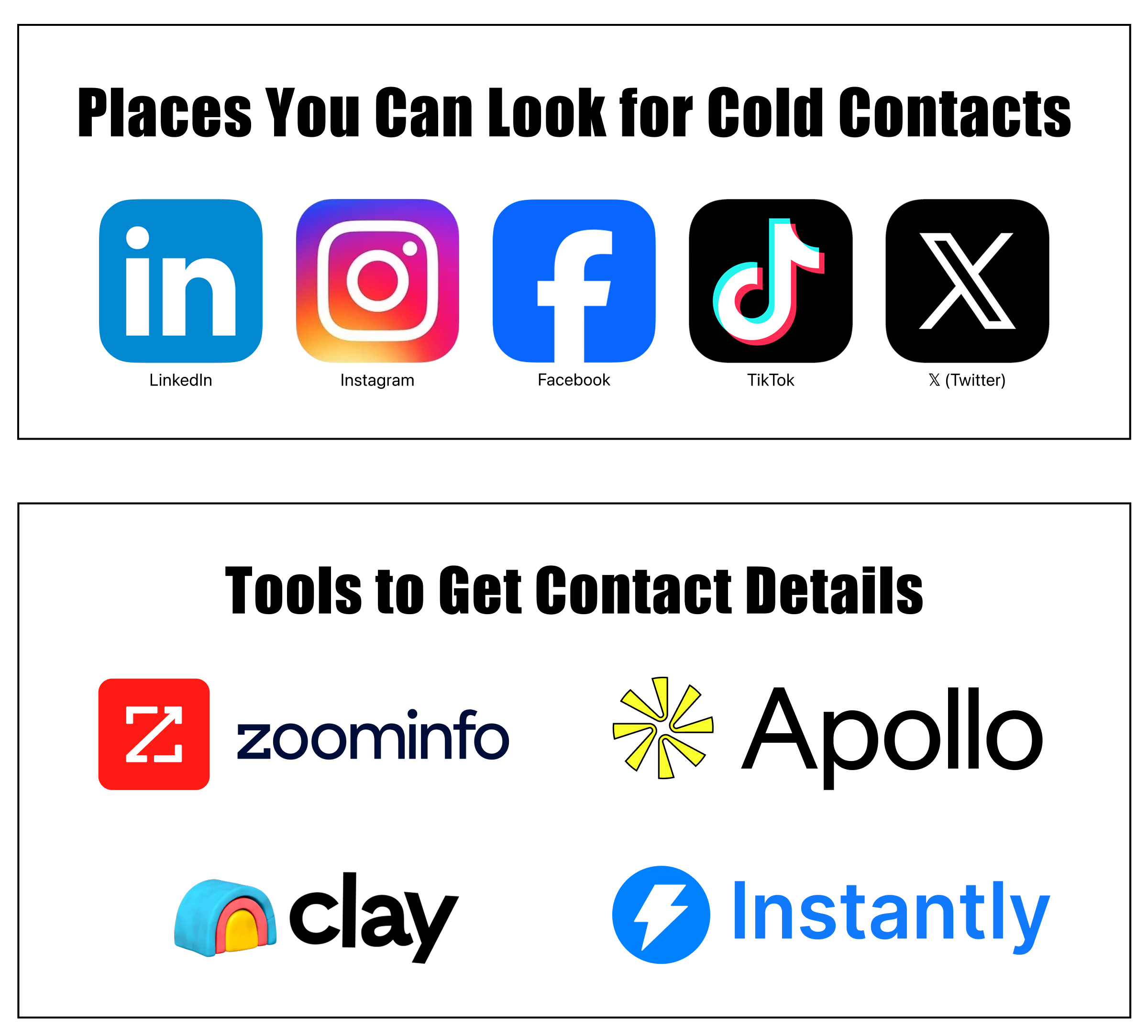
However, unlike with warm outreach, I wouldn’t beat around the bush. When you look them up, look for a reason that would make sense for you to message them. If you can’t find that reason, put their name at the bottom of your list and move onto the next.
You’ll get way more messages sent per hour this way. Volume is the name of the game with cold outreach. Don’t waste your time digging for someone that might not even be there.
Time will pass between now and when you get back to the people you move to the bottom. By then, something new may have happened in their life that gives you a reason to reach out.
Residential (B2C) Outreach Considerations
Cold outreach can be tricky if you’re trying to get residential customers. In general, I wouldn’t recommend texting, emailing, or calling for most HVAC businesses.
It can make sense for larger chains, but if that’s you, you’re probably not reading this article trying to figure out how to get leads.
- Cold Texting: You can’t text potential residential customers because you don’t have their permission. If you do, you’d be violating the Telephone Consumer Protection Act (TCPA) or and might end up slapped with a hefty fine by the FCC.
- Cold Emailing: You can cold email potential residential customers if you adhere to the requirements set forth by the CAN-SPAM Act. Unlike TCPA, CAN-SPAM does not require prior consent before sending unsolicited messages. There are specific guidelines you must adhere to, however. Review the FTC’s website for specific information and the most recent guidelines.
- Cold Calling: Cold calling is regulated by both the FCC through the Telephone Consumer Protection Act (TCPA) and the FTC through the Telemarketing Sales Rule (TSR). You can still do it, but there are rules around things like using autodialers, excluding people from the National Do Not Call Registry (as well as state-level ones), the hours you call, identifying yourself, frequency, keeping detailed records of everything, and more.
The effort required to stay compliant and the fines associated if you don’t just don’t make sense for smaller HVAC companies. You’re better off posting free content online and running paid ads.
That said, you can go door-to-door, direct message people on social, and hand things out to people on the street (so long as you’re adhering to any local ordinances and non-solicitation signage on private property).
Commercial (B2B) Outreach Considerations
Cold outreach is much more viable if you’re trying to get commercial customers.
- Cold Texting: You still can’t text people without their prior consent. It doesn’t matter if they put their cell number on their website, or if it’s a WhatsApp/Telegram number.
- Cold Emailing: Nothing changes here with respect. Emailing B2B is subjected to the same regulations under the CAN-SPAM Act. The main difference is it’s much easier to get business emails from online data brokers than it is consumer ones, increasing the total volume of people you can reach.
- Cold Calling: The same regulations under the TCPA and TSR apply to cold calling B2B numbers with the exception being that B2B calls are exempt from the National Do Not Call Registry requirements as long as you’re calling a businesses main line and not employee’s mobile phones.
As a general rule, if you’re going to do cold outreach, don’t be annoying, keep it brief (but respectful), and try to give the person something valuable for giving you any time out of their day. You won’t get fined by the FTC or FCC if no one reports you. And people won’t report you if you don’t give them a reason to.
Paid Ads
Paid ads give you a way to tell many people at once, who don’t know who you are, about your services. You pay platforms like Google, Meta, and TikTok to get your brand, message, and offers in front of people who use those platforms.
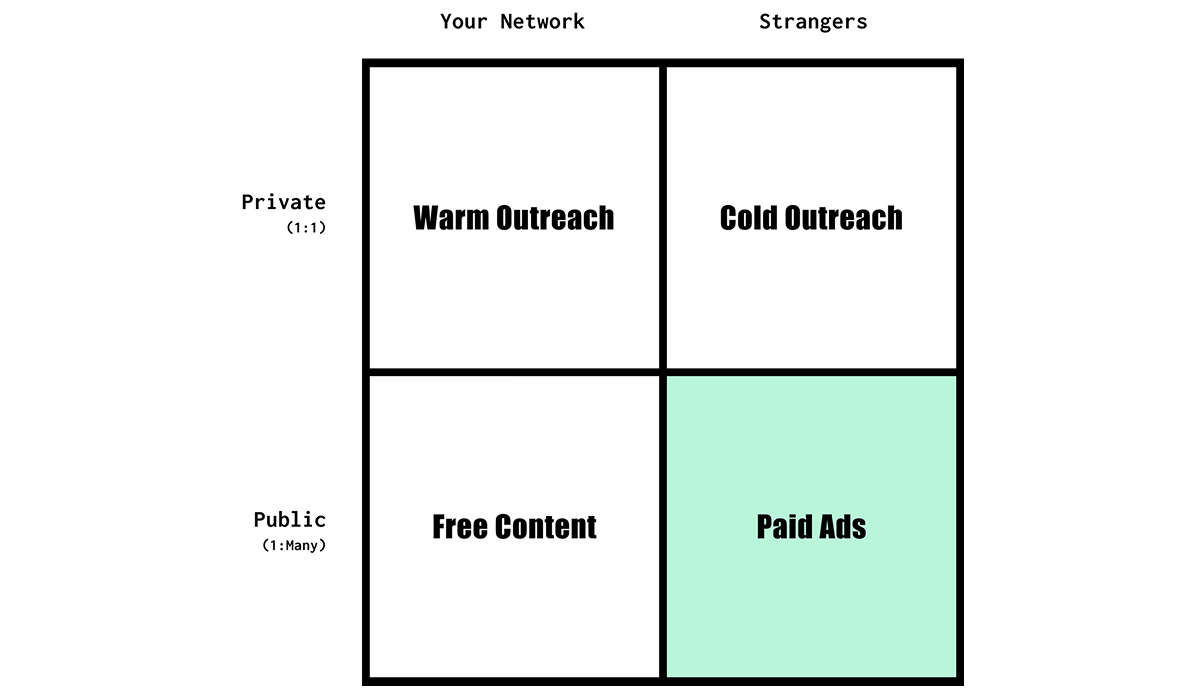
With Google, I’d recommend starting with Local Services Ads, Paid Search Ads (including their option to advertise in the local results also).
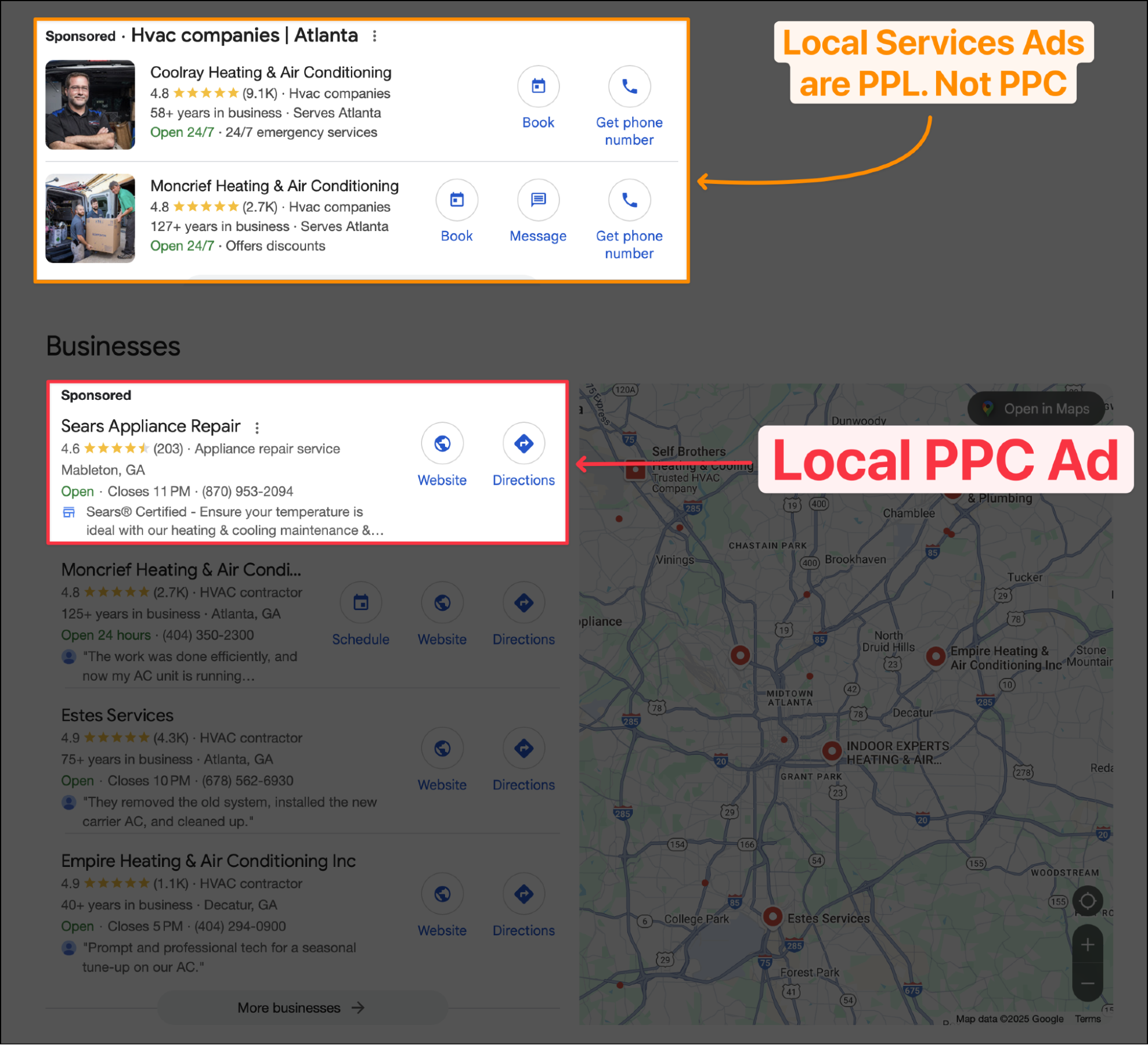
Below are examples of Meta ads. These are ads you might see in the feed but Meta offers a variety of locations where you place ads. A constant stream of good creative is key to success with Meta ads.
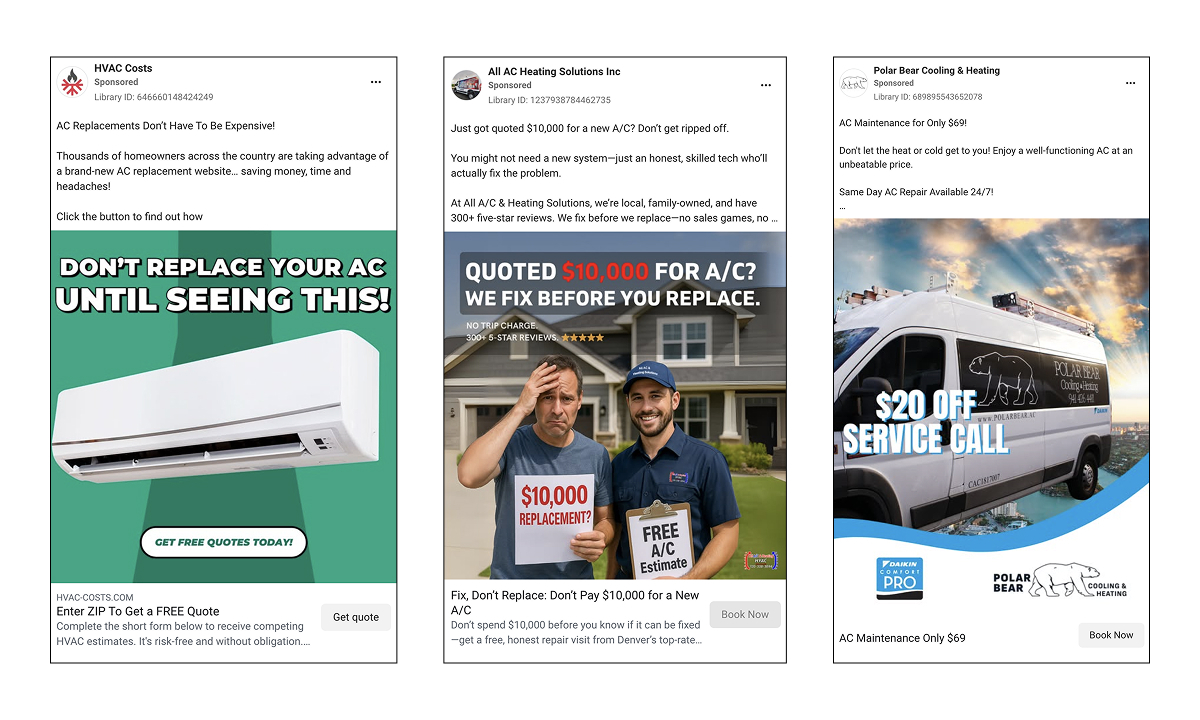
Paid ads can take more effort to get set up and get working well, but once you have things dialed in, provide one of the most scalable ways to get leads.
At the most basic level, getting paid ads to work for lead generation, means figuring out where to advertise, getting the right message in front of the right people at the right time, so they show their interest by giving you their information so you can contact them.
This is why having a killer lead magnet is so important. If you just advertise the stuff you sell you’re going to pay more per lead, per click, per impression, etc.
In addition to your lead magnets, advertise all the proof you can collect. Getting your customers to record short videos from their phone works great because other people talking about how good you are is better than you saying how good you are.
There are a ton of nuances when it comes to paid ads to get HVAC leads. So much that we wrote an entire article about it you should read if you want to learn more: Beginner’s Guide to PPC for HVAC.
Publish Free Content
Publishing free content online gives you a way to tell many people at once about your stuff that either know you or have an interest in what you’re talking about.
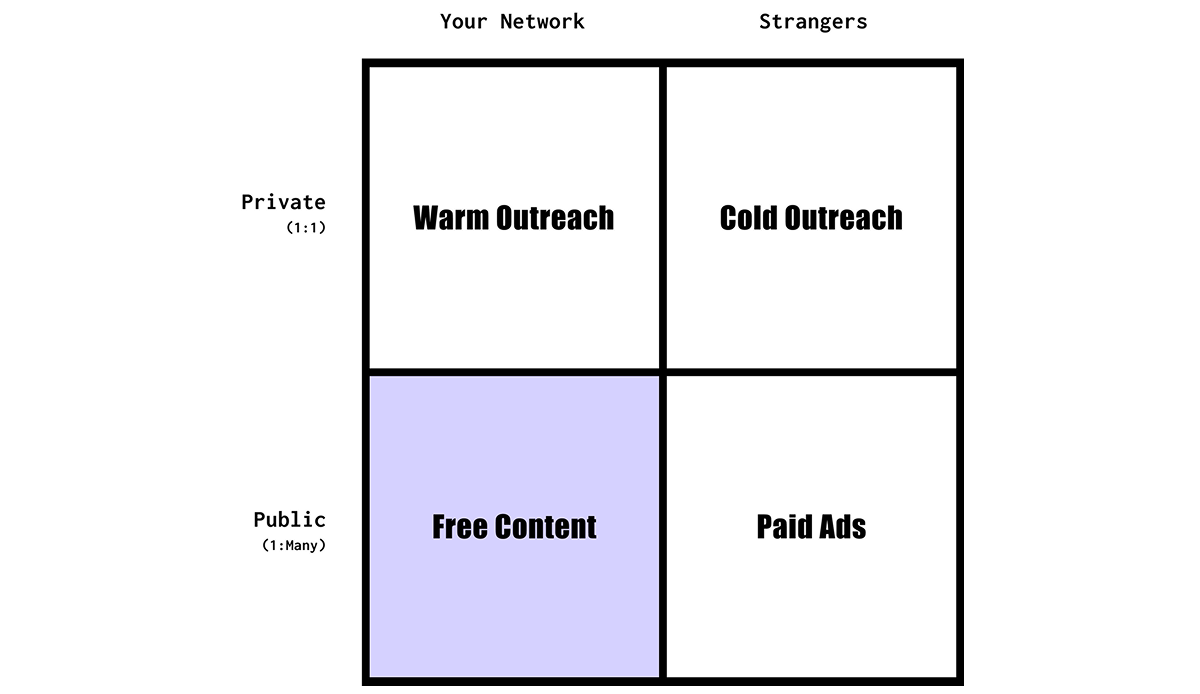
Getting results from posting free content takes the most effort and the most time, but is the only advertising approach capable of compounding returns over time.
Unlike all the other modes of advertising, your goal here is to build your audience by posting stuff people will like, engage with, and want to share with others.
You can post free content on your website and social media.
Free content on your website can bring traffic to your website when people search on Google if you’ve put in the work to rank on them.
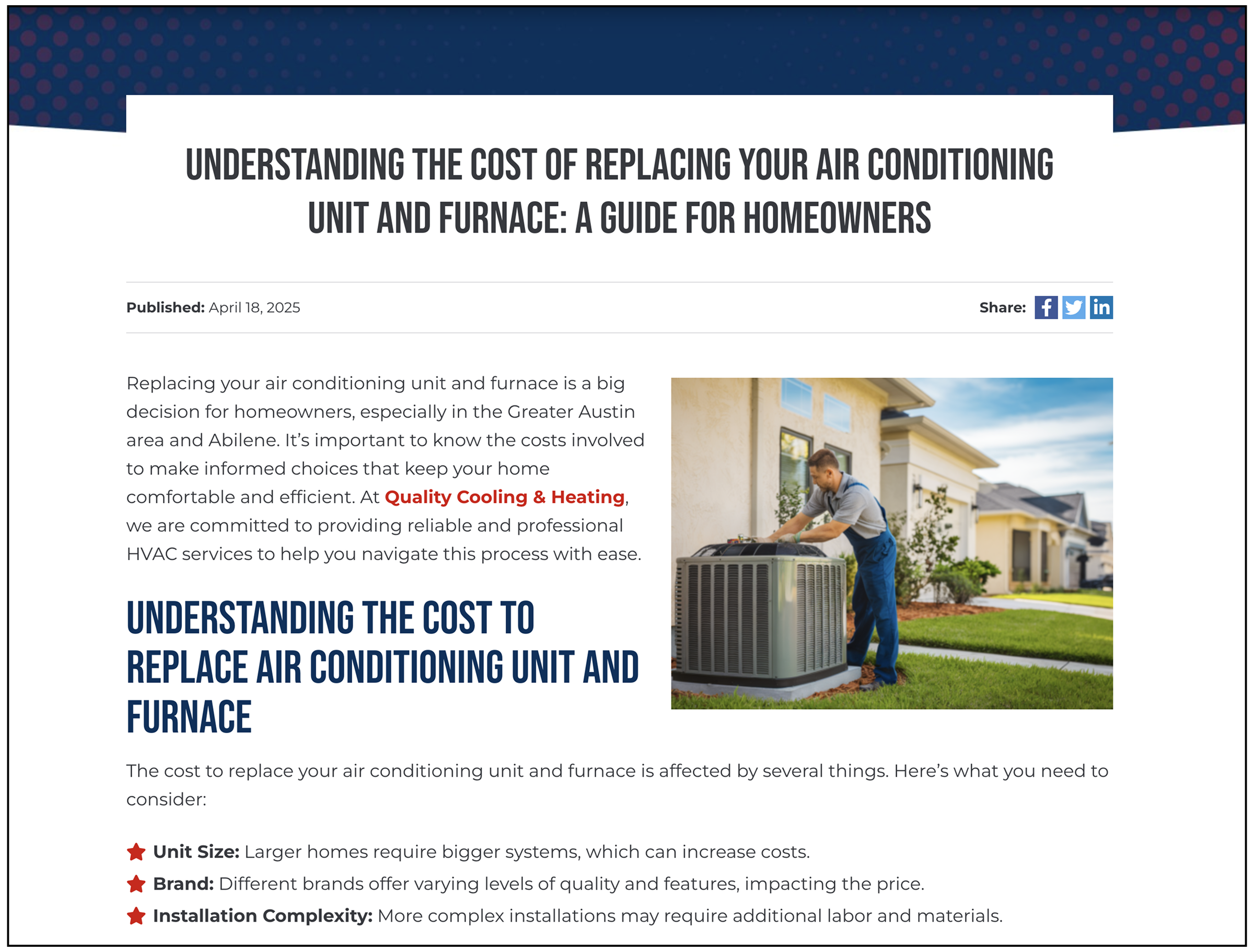
You can also rank in AI chatbots like ChatGPT so you show up when people ask them for recommendations. Here’s an example of what the results can look like:
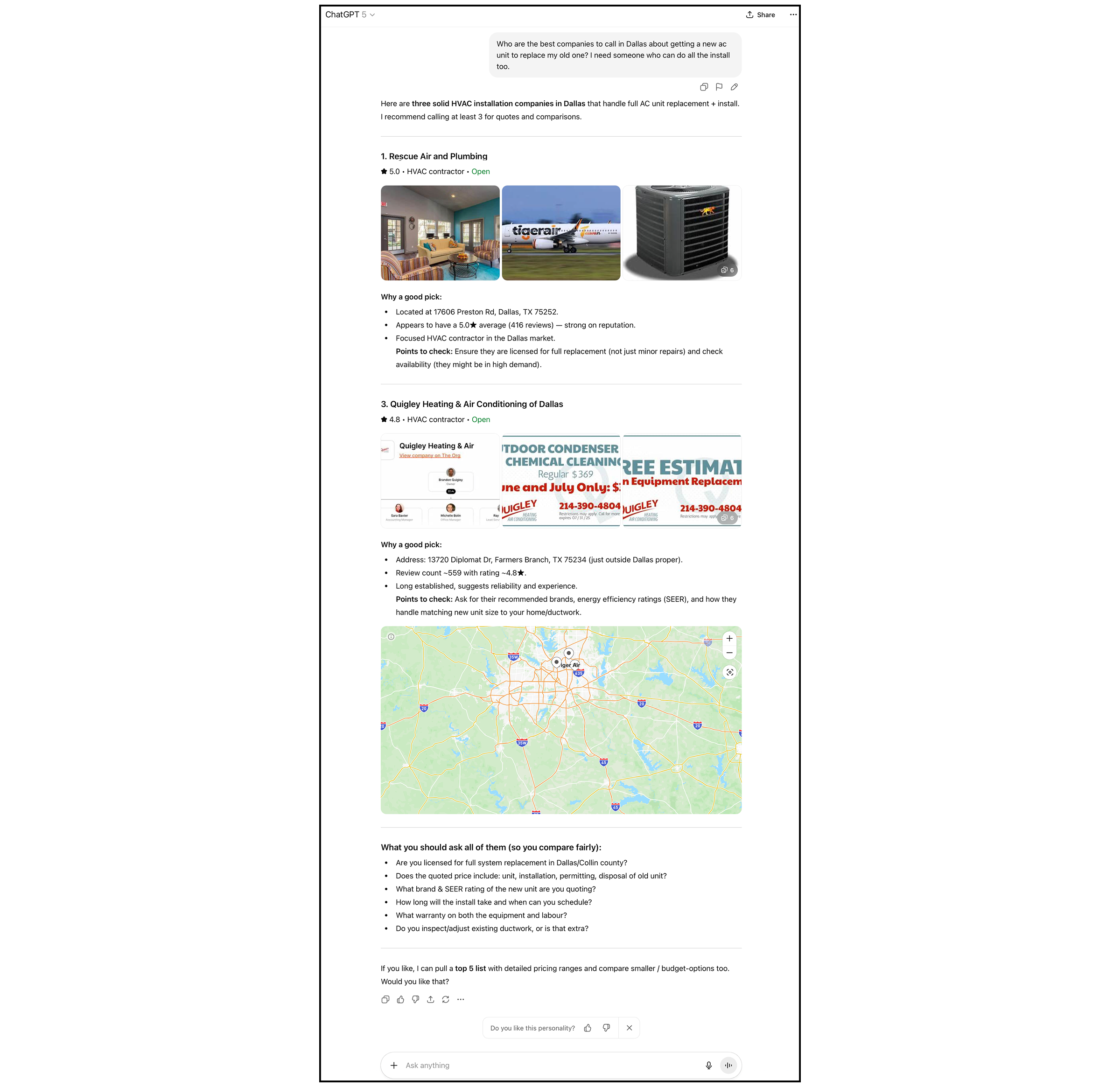
Free content on social won’t bring as many people to your website, but that’s okay. It will reach far more people and therefore make more people aware you exist. Social channels include things like Facebook, Instagram, TikTok, YouTube, LinkedIn, etc.
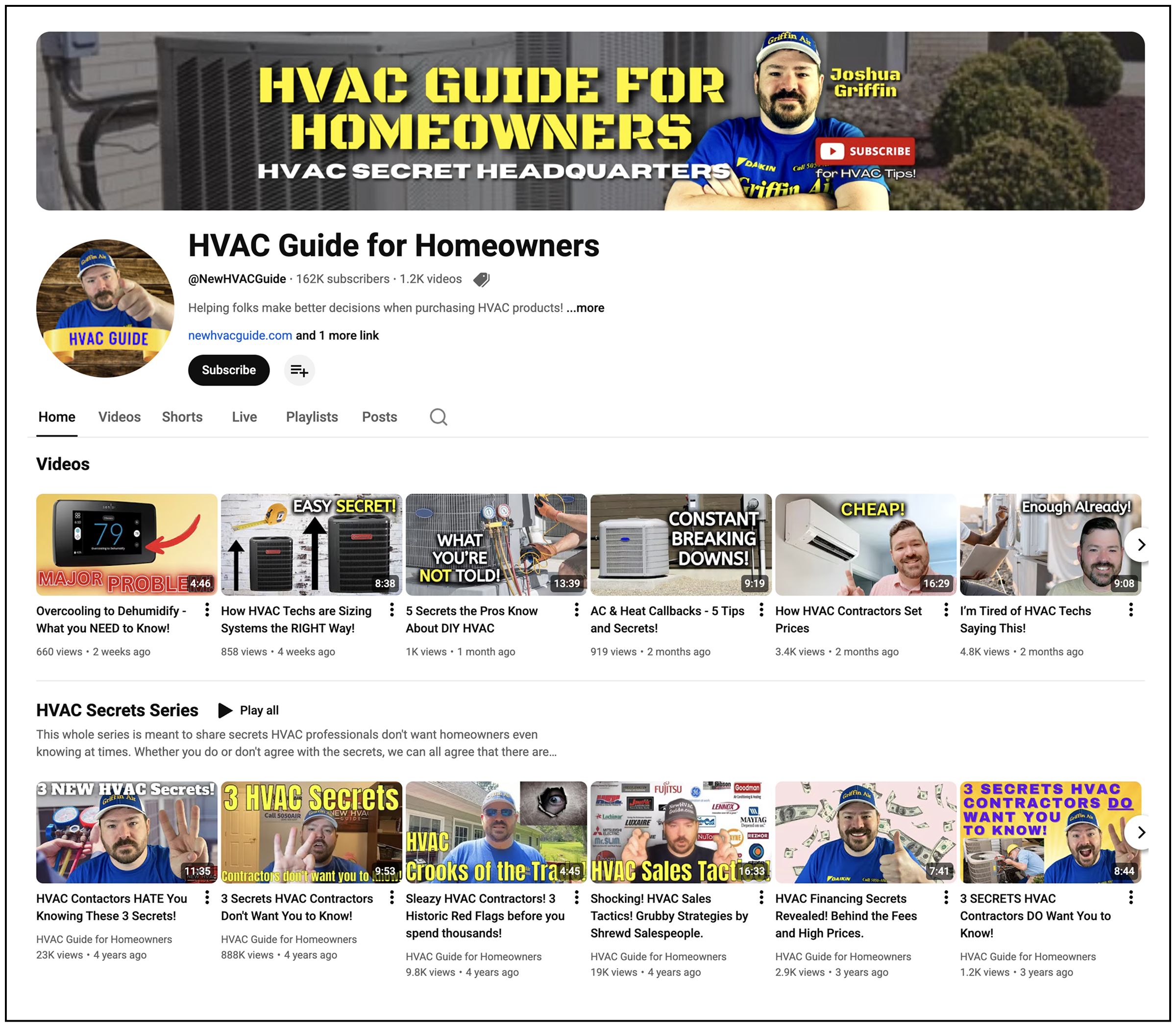
Social content is rocket fuel for every other form of advertising. Content that performs well on social media organically can be reused to make great paid ads.
Posting consistently makes it more likely the people who know you actually remember you when they need the services you offer and make you look a lot more trustworthy when the people you cold message inevitably come look you up online.
You can’t just post service promotions and job photos with some hashtags, hoping it’ll turn into calls. People don’t use social media platforms to see ads. If that’s all you post, fewer people will see your stuff and you’ll never build momentum.
Like paid ads, there’s a lot that goes into making this channel work. But don’t worry, we have an entire guide dedicated to that too: Guide to Social Media for HVAC by Venveo.
What No One Wants to Hear About Scaling Lead Generation
There’s only so much you can do on your own, especially if you’re still doing service calls like a lot of owners still are. But more results requires more work. There are no hacks or shortcuts despite what people may tell you.
Every channel can work. When a channel isn’t working for you it’s not because the channel doesn’t work, it’s because you aren’t good enough. Look around. If even just one of your competitors is making a channel work for them then that means the channel can work.
And instead of jumping from one thing to another, pick one, stick to it, and do so much volume it would be unreasonable for you not to succeed. The only exception is free content, start that as soon as possible and pair it with another since it acts as a force multiplier for everything else.
If you’re struggling to get a channel to work, that’s normal. Everything worth doing is hard before it gets easy.
If you’re struggling to just do more volume, that’s normal too. Time is a finite resource and everyone has the same 24 hours in a day.
Every day you don’t have the skills it takes to get leads is costing you the money you could be making. Every hour you don’t have in a day to advertise is costing you money you could be making.
You can either put in the time to learn it and get better or you can hire people who already know what they're doing and collectively have more hours in a day to devote to it than you do on your own.
Either way you’re paying for it. There’s no way around that.
If you want more consistent leads that are worth more, but would rather just pay someone else to do it for you, then click here to talk to one of our HVAC Lead Generation experts and learn what your business (and life) could look like when you don’t have to worry about getting leads anymore.





